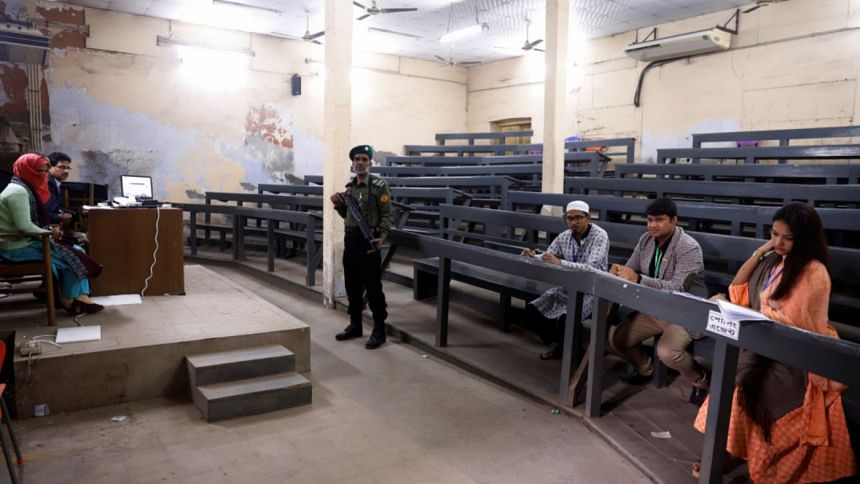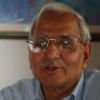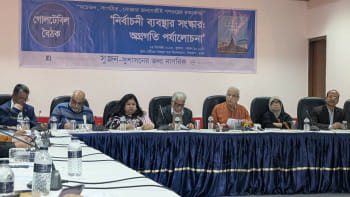Low turnout: the new normal?

One question that I repeatedly faced in the last few days was: how were the elections of the two Dhaka city corporations? So we set out to find an answer by conducting a post-election online polling, in which over 4,000 individuals responded. Around 94 percent of those who responded indicated that the elections were not credible. Although online polling doesn't follow a scientific method of appraisal, it serves as an indication about public perceptions about important matters. I also asked nearly two dozen journalists about their opinion on the recent elections. Unfortunately, none of them thought that the elections were free and fair.
On the day of election on February 1, I visited seven centres—four of which were in Dhaka North and the remaining three in Dhaka South. In those centres, I spoke with the Presiding Officers and other election officials. I also spoke with many voters. During my visit, I found a large number of individuals wearing the badges of the candidates nominated or supported by the ruling party, loitering both within and outside the centres, violating the election law. They were mostly young and appeared to be part of a showdown.
But I found few voters in the centres, and there was generally little interest in elections among the public. I did not see any agent of the opposition mayoral candidates in the centres that I visited. I also observed no violence in those centres, which was a positive aspect of these elections. Some of the election officials told me that unlike the last national election, they did not feel the same type of pressure. Overall, there appeared to be widespread voter apathy and resignation.
This voter apathy has been reflected in low turnout. For example, in one of the booths of Bangladesh Textile University centre, 30 out of 359 or 8.36 percent votes were cast by 12 noon. In one of the centres of Segunbagicha High School, 244 out of 3,198 or 7.63 percent voters cast their votes by noon. In the centre at Begum Rahima Ideal School, 392 out of 2,373 or 16.52 percent votes were cast by 2 pm. In the Mohammadpur Preparatory School centre for men, 400 out of 2,232 or 17.92 percent votes were cast by 2 pm. In another centre nearby, 270 of out of 2,693 or 10.03 percent votes were cast by 3 pm. Such low turnout which I personally observed is not consistent with the Election Commission's declared results of 25.34 percent for Dhaka North and 29 percent for Dhaka South.
Doubts have also been raised about the declared results because of the EC's inability to declare them until late in the night, although the results from EVMs should have been instantaneously available. Already, accusations of tempering the results and "digital manipulation" were raised in cases of some councillor candidates. According to a report by Daily Manabzamin, the results of ward 31 of Dhaka South were postponed due to the complaint of fraud by AL-supported councillor candidate Sheikh Mohammad Alamgir.
Broadly speaking, the low turnout in the two city corporation elections can be attributed to four reasons: first, concerns about the dependability of EVMs. The EVMs used in the elections do not have the Voter Verifiable Paper Audit Trail (VVPAT)—a safeguard added to the EVMs used by the Indian EC in 2011 on the direction of their Supreme Court. It may be noted that Professor Jamilur Reza Choudhury, who served as head of the Technical Advisory Committee formed by the EC itself, did not approve its recommendation for procuring EVMs without VVPAT. The EC still went ahead with it. With the VVPAT, votes could be recounted and this would easily resolve some of the accusations raised about the results.
Another weakness of our EVMs is their inability to read the biometrics of some voters to identify them, as it happened in case of Dr Kamal Hossain and even the CEC himself. Because of this weakness, the election officials were given the authority to override the EVMs and upload the voters' identity. In the last national election, election officials had this authority in cases of up to 25 percent of the voters. In the recent elections, such authority was apparently limited to 1 percent, which could be raised by a special code given by the Returning Officers and by the EC. If the election officials could upload voters' identity without their biometrics, they could also cast votes in the absence of voters in the polling centres. Already, there are accusations of abuses of this authority. It may be mentioned that 45 of Dhaka North centres had the declared casting rates of over 50 percent, the highest being 78.21 percent. Similarly, 50 of Dhaka South centres had the declared casting rates of over 50 percent, the highest being 77.40 percent. Incidentally, the headline of a recent article by The New York Times was: "The only safe election is a low-tech election." (February 4, 2020).
The second reason for low turnout is: lack of trust in the EC, which is responsible for using the EVMs. Because of the commission's partisan roles in the past elections, many citizens have become resigned—they have come to realise that their votes would not make any difference. In addition, they felt that they may not be allowed to vote even if they went to the polling centres. Even many ruling party supporters also did not show up to vote because of their confidence that their candidates would win in one way or another.
The third reason for low turnout: the showdown in and around the voting centres created a security risk, which also discouraged many voters. They were afraid that they might be harassed and even prevented from voting by the ruling party supporters who were largely in control of the polling centres. Such fear mostly discouraged the supporters of the opposition candidates as their party failed to provide a sense of security in the face of the illegal gatherings.
Finally, voter suppression. I received complaints that in some places, the people around the polling centres created fake queues to prevent actual voters from entering them and vote. In some cases, the voters with known affiliation with opposition political parties were not allowed to go in, and in certain cases, were roughed up. The news of such harassment spread quickly in the social media, discouraging many voters from venturing to visit the polling stations.
I have also received many complaints from voters that they could not freely exercise their franchise as they were forced by the "helpers" in polling booths to cast votes for certain candidates or those people voted on their behalf. Some voters were warned that with EVMs, their votes would not remain anonymous, so they should be careful who they vote for. Some other voters were allegedly told that their voting was completed after using finger prints to upload their identity.
Overall, it is clear that the recent city corporation elections were also "controlled," although differently than in the past, and controlled elections and the increasingly low turnout have now become a new normal in Bangladesh's politics. As a result, the concerns that voters had about EVMs and their lack of trust in the EC could not be overcome, rather those were further deepened by the recent elections. This has created the risk of a complete breakdown of our electoral system with dire consequences, for elections are the only lawful and peaceful way of changing power. If the peaceful means of a transfer of power disappears, we may be headed toward an ominous future, the consequences of which will have to be borne by everyone, irrespective of party affiliation.
Dr Badiul Alam Majumdar is Secretary, SHUJAN: Citizens for Good Governance.

 For all latest news, follow The Daily Star's Google News channel.
For all latest news, follow The Daily Star's Google News channel. 



Comments